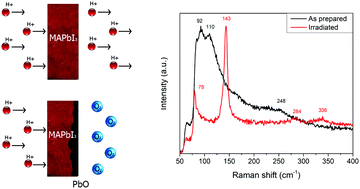Effect of high energy proton irradiation on MAPbI3 films for space applications observed by micro-Raman spectroscopy†
Abstract
Irradiation of samples with 10 MeV protons is a standard test for simulation of the outer space environment in order to qualify devices and materials for space applications. Micro-Raman spectroscopy allows one to determine the irradiation effect on methylammonium lead iodide (MAPbI3) thin films under ambient conditions and encapsulated. For the unprotected films, the vibrational modes matched previously reported lead oxide phonon frequencies and the appearance of superficial oxides was confirmed by EDAXS analysis. However, the Raman shifts corresponding to PbO were not observed for the irradiated encapsulated samples, indicating that oxidation occurs after surface exposure to ambient oxygen. Similar effects have been observed by photooxidation where the highly reactive superoxide radical is involved in the oxidation mechanism. We propose that irradiation promotes excitation of the electron cloud, which readily reduces the surface adsorbed oxygen, and this later bonds to the accessible Pb atoms.



 Please wait while we load your content...
Please wait while we load your content...